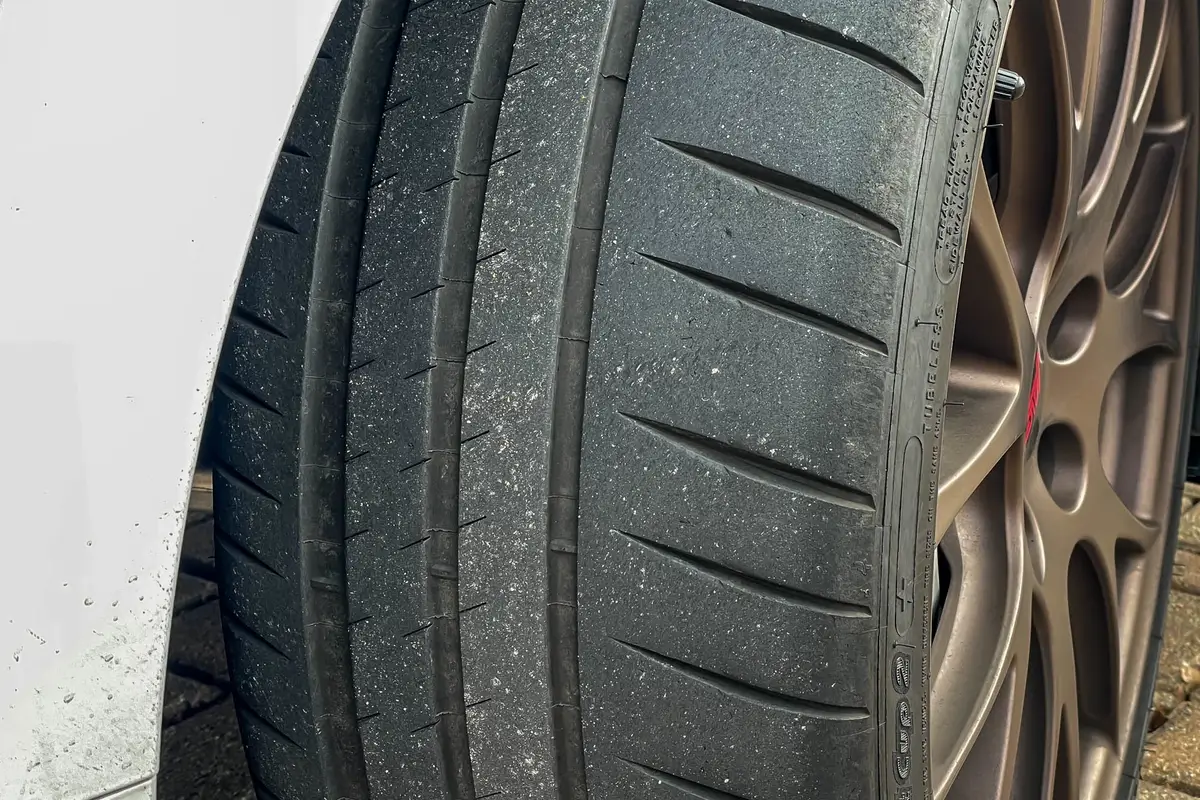What’s the Difference Between Summer, Winter and All-Season Tires?


Drivers rarely think about tires until one goes flat or it’s time to buy new ones. They may not even know what type of tire their vehicle is driving on or if it’s the right fit, be it all-season tires, winter tires made exclusively for cold weather or summer tires designed for aggressive warm-weather driving. Which one is right for you?
Related: How to Read a Tire Sidewall
All-season tires are by far the most popular tire type as original equipment on new vehicles and as replacement tires because they’re the most versatile and best suited to the needs of most drivers. Many performance cars, though, come with summer tires as standard equipment, and some drivers might be tempted to switch to summer tires when they buy new ones. Whether your vehicle is riding on all-seasons or summer tires, if you live in an area that sees cold temperatures and snow, you could hear a sales pitch to buy winter or all-weather tires that perform better during those frigid months.
No type of tire is ideal for every situation or time of year, so it pays to know their strengths and weaknesses. Here’s what to know about each type.
All-Season Tires
All-season tires are jacks of all trades but masters of none. They perform well enough in most situations that they can be used year-round whether the pavement is dry, wet or covered by snow, and they generally fall short only in severe driving conditions, such as deep snow or on a racetrack.
These tires usually have many grooves and sipes (which are small slits in the tread) that help them deal with a variety of conditions, such as rain and snow. They tend to last longer than other types and are usable on hot pavement. The longest-lasting all-seasons can come with tread-life guarantees of more than 50,000 miles and as high as 85,000 miles. All-season tires tend to be quieter than performance tires because many drivers are looking for a tranquil ride. Some also have low rolling resistance, which means they will yield higher fuel economy than other types.
Compared to summer tires, though, even grippier, performance-oriented all-season rubber won’t have as much grip in turns or steering precision and will have longer stopping distances. Summer performance tires grip like leeches, but all-season tires sacrifice some traction for a smoother, quieter ride and longer tread life. Furthermore, when the snow gets deep or temperatures plunge below freezing, all-season tires won’t perform as well as winter tires.
Summer Tires
Summer tires are commonly installed on performance vehicles as original equipment because they prioritize traction above ride comfort and noise. These performance tires tend to have wider treads to put more rubber on the road and lower profiles (the height of the sidewall) to reduce sidewall flex in aggressive cornering, which helps keep the tires firmly planted to the road.
These tires enable the vehicle to carve through turns faster and with more control and provide shorter stopping distances than all-season tires. They can even come with speed ratings upward of 186 mph, whereas all-season tires are usually rated for sustained speeds of 149 mph or less. Summer tires have shallower treads and fewer grooves than all-season tires, and they tend to wear faster because their tenacious grip leaves more rubber on the road. Certain tread patterns also handle quite well in the rain, provided the weather isn’t too cold and you haven’t worn down those shallower tread blocks too far.
Winter weather poses serious challenges for summer tires. The wider, shallower tread traps snow instead of dispersing it to the sides, making it harder to get traction even in light snow. Cold temperatures make summer tires’ rubber less flexible and unable to grab the road like it can in warm weather, so they can have a noticeable loss of traction even in dry conditions. Tire companies recommend switching to winter or all-season tires in areas where cold temperatures or snow are likely.
Summer tires are usually limited to sizes that fit sports cars and performance models, unlike all-season tires, which are usually available in a range of sizes that fit a variety of vehicles from sedans to SUVs. For example, a Chevrolet Corvette will have more options for summer tires than a Toyota Sienna.
Winter Tires
Winter tires (also called snow tires) provide better traction in snow, on ice and in cold temperatures than either all-season or summer tires. They have deeper treads and more grooves that manage snow and slush better, with more sipes on the edges to improve traction on ice. Winter tires also use rubber compounds that are more pliable in cold weather, enabling them to maintain traction and braking performance.
Decades ago, snow tires had knobby tread designs similar to off-road tires and were designed to be mounted only on the drive wheels of rear-drive vehicles. Now, winter tires should be mounted on all four wheels, whether a vehicle has rear -, front- or all-wheel drive. They aren’t designed to be driven in summer weather because they lose grip and wear faster on hot pavement, so they should only be used when temperatures are consistently below about 40 degrees.
One important difference that summer and winter tires have from all-season tires is that most don’t have mileage-specific tread-life warranties. They are covered by workmanship and materials warranties for manufacturing defects. Michelin is one exception, but the mileage warranties are shorter for summer and winter tires: The brand gives its Primacy MXV4 all-season tire a 60,000-mile warranty depending on speed rating; for the Pilot Sport 4S summer tire and the Pilot Alpin 5 winter tire, however, it’s only 30,000 miles.
In addition, winter tires are not rated under the Uniform Tire Quality Grading standard, wherein tire manufacturers are mandated by federal law to assign a number rating for treadwear and letters for temperature resistance and traction.
All-Weather Tires
If you live somewhere that only has a few days of wintry weather per year, you may not be too keen on buying an entire new set of tires just for three days. That’s where all-weather tires come in, which are sometimes also called premium traction tires.
Like all-season tires, all-weather tires’ performance suffers from trying to do a little bit of everything and simply will not be as good as more specialized summer and winter tires. You can leave them on in the summer months without them rapidly degrading like winter tires often do on hot pavement. All-weather tires often come with comparable mileage-based warranties to all-season tires, too, with the Michelin CrossClimate 2 having a 60,000-mile warranty, for example.
However, like winter tires, these qualify for the American Society for Testing and Materials’ three-peak mountain snowflake symbol (3PMSF for short), demonstrating that they passed a number of acceleration tests in medium-packed snow and have 110% of the traction of a designated reference all-season tire. Keep in mind that these aren’t designed to handle heavy snow, though, and those looking to travel through more extreme winter weather should probably swap to winter tires anyway.
More From Cars.com:
- Do EVs Wear Through Tires More Quickly Than Gasoline Cars?
- Pickup Trucks 101: Choosing the Right Tire
- How Long Do Tires Last?
- How to Check Tire Tread
- What Should My Tire Pressure Be?
Related Video:
Cars.com’s Editorial department is your source for automotive news and reviews. In line with Cars.com’s long-standing ethics policy, editors and reviewers don’t accept gifts or free trips from automakers. The Editorial department is independent of Cars.com’s advertising, sales and sponsored content departments.

Contributor Rick Popely has covered the auto industry for decades and hosts a weekly online radio show on TalkZone.com.
Featured stories



